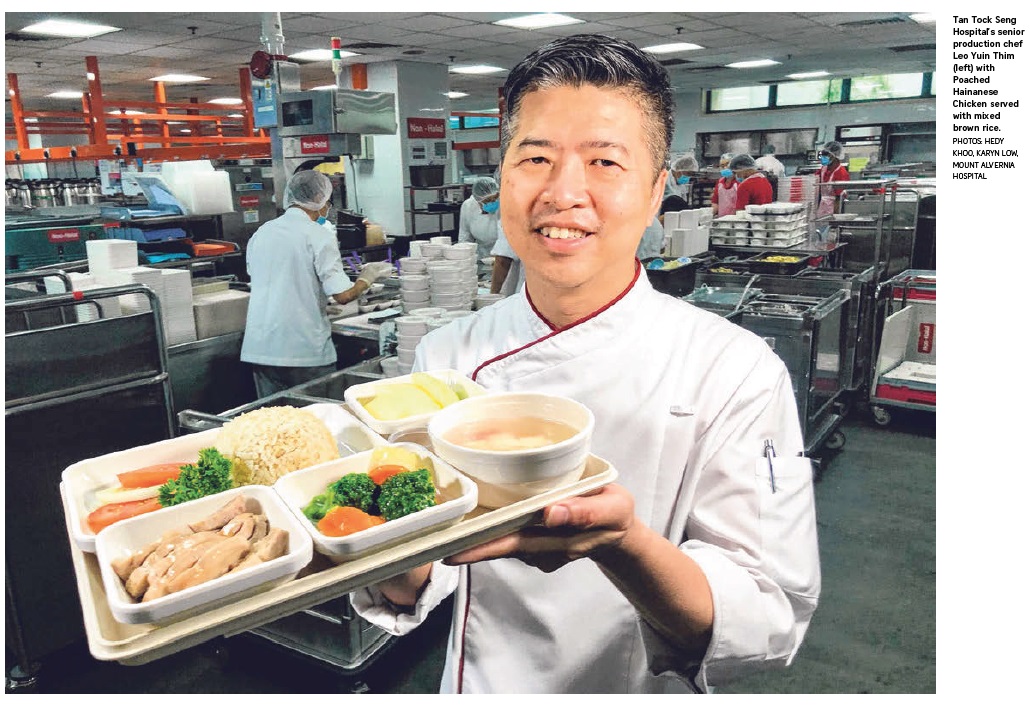The Straits Times (7 July 2019)
Restaurant-worthy food served in hospitals is part of patients’ recovery process

When Ms Karyn Low was admitted to Mount Elizabeth Novena Hospital for spinal injuries in April, the last thing she expected was to dine on lobster for dinner.
The 49-year-old, who is head of marketing communications at a finance company, says: “I was in pain and worried about my condition. The lobster dinner cheered me up completely and I did not feel like a patient. I could tell less salt was used, but the dish was still tasty.”
She enjoyed the food so much that she was disappointed when she was discharged early the next day and did not get to eat her lunch order of Slow-cooked Aged Black Angus Beef Short Rib.
Breaking the stereotype of hospital food being bland and boring, hospitals are serving their patients a tantalising range of dishes which are both enjoyable and healthy.
They span different cuisines and include options such as freshly made chappati with curry chicken at Tan Tock Seng Hospital and Seven-hour Braised Lamb Shank Biryani, a signature dish at Gleneagles Hospital.
Other dishes that might pique a patient’s interest are the frequently ordered Ayam Masak Merah (spicy chicken) at Changi General Hospital and Seafood Penang Kway Teow at Raffles Hospital.
The Wok-fried Lobster With Ginger And Spring Onion which Ms Low had during her stay at Mount Elizabeth Novena Hospital is the hospital’s star dish.
While the dishes look effortless on the plate, a lot of planning goes on behind the scenes.
In hospitals, food is regarded as nutritional therapy that is part of the patients’ recovery process, so menus are carefully put together by dietitians and chefs, who consider the ingredients and cooking methods, and develop recipes which meet the dietary requirements of patients.
Other factors considered include dietary restrictions, allergies, gender, age, physical activity, variety and presentation to stimulate appetites.
Menus can take up to a year of planning before implementation.
There are two broad categories of diets – regular diets where patients have no dietary restrictions and therapeutic diets for patients with dietary restrictions such as those with diabetes.
But even for patients on regular diets with no dietary restrictions, food is prepared with less sodium and oil using healthier cooking methods.
Group executive chef and senior food, nutrition and beverage manager for Parkway Pantai’s hospitals in Singapore Catan Tan, 52, says the lobster dish at Mount Elizabeth Novena Hospital is first steamed then stir-fried, so that less oil is used in the cooking process.
Hospitals say emphasis is on fresh ingredients while avoiding the use of artificial flavouring and colouring. To add visual appeal to the food, care is given to the selection of crockery and natural colours of food like fruit and vegetables are used to brighten up a dish.
Chefs also turn to herbs and spices for flavour.
Ms Natalie Goh, 47, chief dietitian for Parkway Pantai’s hospitals in Singapore, says: “We want to give the patients a variety of choices. When they feel happy, they eat better. Emotions do play a part in the patient’s recovery.”
Ms Sarah Sinaram, 40, head of nutrition and dietetic services at Mount Alvernia Hospital, agrees. “Food and nutrition for a patient is important as it is part of the holistic healing that our hospital advocates. It can decrease length of stay, reduce reliance on medication and improve clinical outcomes for the patients.”
Director of Changi General Hospital’s department of food services Magdalin Cheong, who has been a clinical dietitian for more than 25 years, observes that “expectations of patients are different now” and hospital food has evolved from being purely functional to also being aesthetically pleasing.
She says: “These days, hospital food is of hotel standard, presented in an appetising way to meet the nutritional needs of patients and aid their recovery.”
Even for patients who have difficulty swallowing and are on texture-modified diets, effort is made to cook flavourful food that is then minced, chopped or blended.
It is not uncommon for hospitals to hire chefs with hotel and restaurant experience. At Changi General Hospital, which has a food service team of more than 70 people, many of its chefs have such experience.
The hospital also sends its chefs for further culinary training at AtSunrice GlobalChef Academy. Tan Tock Seng Hospital’s senior production chef Leo Yuin Thim, 54, was a hotel chef before he joined the hospital in 2010.
He says: “In a restaurant, people are there to enjoy themselves, but in a hospital, we are cooking for people who are troubled by their medical conditions.” Chef Leo recalls an incident last year when he was told a patient wanted to see him.
Expecting to receive negative feedback about the food, he was surprised when the elderly patient, who was on a texture-modified diet, thanked him for making her meals tasty.
The patient’s daughter told him that her mother, who did not have much of an appetite at home, enjoyed her meals in the hospital. The daughter asked him to share his recipes so that she could cook the dishes for her mother at home.
He gladly did so.
Chef Leo says with emotion: “Being able to play a role in a patient’s recovery process gives meaning to my job.”